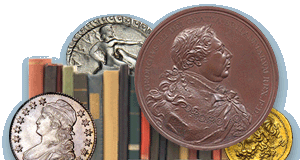
PREV ARTICLE
NEXT ARTICLE
FULL ISSUE
PREV FULL ISSUE
NICKLE GALLERIES COINS OF ISLAM EXHIBITSorry for the delay - this exhibit has already closed, but I wanted to document it. The University of Calgary's Nickle Galleries recently mounted an exhibit of Islamic coins. -Editor
COINS OF ISLAM
Coins of Islam explores the rich and diverse history of Islamic coinage, tracing its evolution from the 7th century to the height of the Fatimid Dynasty and beyond. Islamic coins served as more than currency; they were symbols of power, faith and propaganda, and canvases for exquisite artistic expression. From the earliest coins inscribed with Arabic script and influenced by Byzantine and Sasanian designs, to the intricate calligraphy and bold patterns of later dynasties, these artifacts reveal a dynamic interplay of faith, culture, and authority. The exhibit reveals how Islamic coins reflected the artistic and intellectual achievements of their time, featuring messages of unity and power. This display provides a unique lens into the artistic, political, and cultural heritage of the Islamic world, offering a testament to centuries of innovation and creativity.
Curated by Marina Fischer
HISTORY OF ISLAMIC COINAGE
Islamic coins have a rich and fascinating history that spans centuries and reflects the diverse cultures and civilizations that have shaped the Islamic world from the early days of Islam in the 7th century to the present day. Islamic coins have been used as a means of exchange, a symbol of power and authority, and a reflection of the artistic and cultural achievements of the Islamic world. The history of Islamic coins begins with the emergence of Islam in the Arabian Peninsula in the 7th century. The first Islamic coins were based on the existing Byzantine and Sasanian coinage that was in circulation in the region at the time. These early coins were inscribed with Arabic script and featured symbols and motifs that reflected Islamic beliefs and practices. As Islam spread throughout the Arabian Peninsula and beyond, Islamic coinage began to evolve and take on new forms. The Umayyad caliphs, who ruled from 661 to 750, introduced gold and silver coins that featured inscriptions in Arabic and images of the caliph on one side and religious symbols on the other. These coins were minted in large quantities and were used to fund the vast expansion of the Islamic Empire. The Abbasid caliphs, who succeeded the Umayyads in 750, continued the tradition of Islamic coinage and introduced new designs and motifs that reflected the cultural and artistic achievements of the Islamic world. Abbasid coins featured inscriptions in Arabic and Persian as well as images of animals, human figures and geometric patterns. These coins were highly valued for their artistic and aesthetic qualities and were used as a means of trade in exchange throughout the Islamic world. Islamic coinage reached its pinnacle of excellence during the rule of the Fatimid Dynasty in Egypt which lasted from 909 to 1171. Fatimia coins were renowned for their intricate designs, bold calligraphy and striking use of colour. Many of these coins featured images of the Fatimid caliphs as well as depictions of animals, birds and other natural elements.
To read the complete exhibit brochure, see:
Wayne Homren, Editor The Numismatic Bibliomania Society is a non-profit organization promoting numismatic literature. See our web site at coinbooks.org. To submit items for publication in The E-Sylum, write to the Editor at this address: whomren@gmail.com To subscribe go to: Subscribe All Rights Reserved. NBS Home Page Contact the NBS webmaster 
|


